Students Scientific Research Capacity In The Technical Universities From Romania – Case Study On The Personalization Of It Products
Abstract
This study aims at identifying the current state and perspectives on issues related to the students’ scientific research capacity in technical universities from Romania, as well as the intention to disseminate the results. This paper presents a research based on a questionnaire (more than 320 respondents– students, graduates from technical universities in Romania). Among the questioned issues: the steps of a research, how the design of a research is done, research instruments and methods, reporting in research, the dissemination of the research results, methods of data collection and analysis, the necessity and usefulness of a good practice guide on how to conduct a scientific research, the usefulness of face to face / virtual training sessions on topics of interest regarding the way of carrying out a scientific research in order to increase the interest, the research capacity and publication of the results. The case study reflects issues like: the necessity of research in the field of personalization of IT products, the need for students in different learning cycles to know and research the IT product personalization field in order to form abilities, to increase their chances of being employed and to grow the competitiveness of the companies they will work for, the need for a guide (for the students’ use) to good practice on personalizing IT products, the need for training sessions to increase the level of knowledge (and skills) amongst students in the field of personalization of IT products and to grow students' ability to personalize IT products.
Keywords: Personalization of IT productsscientific research capacitystudents and graduatestechnical universities
Introduction
According to OECD (2001), research means any creative systematic activity undertaken in order to increase the stock of knowledge, including knowledge of man, culture and society, and the use of this knowledge to devise new applications. A
Team work / interaction with the research team in order to create a positive research environment;
Technology / IT skills;
Some project management skills
Some handling budgets knowledge;
Enthusiasm - is a promoter of a good experience in research.
There is a different approach of doing research in university vs in industry. In university an advisor has a small number of students/colleagues and can rely on the infrastructure from the university but most of their research funding must come from outside grants. In industry the organization is the financier of the research and the infrastructure of the company is most often used. If we talk about students (bachelor, master and Ph.D level) and their capacity to do research there are a lot of specific things that are to be taken into account. As a teacher you must work with the best students to do research. Your relationship with your students is an important component of their present and future success as researchers. Good research advisors find a way to help their students mature as researchers, find and solve their own problems, and learn the mechanics of doing research and participating in a professional research community (Berman, 2018). In order to build the students research team you must (adaption by Berman, 2018):
find good students – especially by observing them at the classes and by offering the funding opportunities;
develop the students – you are their advisor, you train them in doing research;
support the students – it is essentially that the students not to have a job and to work only as a researcher and because of that the advisor should support the students financially, intellectually and emotionally.
encourage the students to disseminate / publish their work;
promote the students – help them to have a large professional network etc.
Problem Statement
Science is an activity with far-reaching implications for modern society. Understanding how the social organization of science and its fundamental unit, the research team, forms and evolves is therefore of critical significance. A research team is a group of researchers collaborating to produce scientific results, which are primarily communicated in the form of research articles (Milojević, 2014).
Undergraduate research experiences provide a window on science in the making, allowing students to participate in scientific practices such as research planning, modeling of scientific observations, or analysis of data (Linn et al., 2015). The experiences are intended to enculturate students into scientific investigation (Feldman et al., 2013).
The paper is a study about the students scientific research capacity in the technical universities from Romania and also proposes a case study on IT products personalization which can be defined as any change brought to a software that is requested by the customer in order to fit the customer’s needs. Customization and configuration are not the same concepts, customization implies that changes are made at software code level while configuration implies changing a range of predefined parameters (adaption from https://www.centricsoftware.com/, 2015)
Research Questions
Here are some questions to which the research responds:
What types of scientific research do the respondents know?
Do the respondents know research instruments and methods?
Do the respondents know the steps of a research?
What are the common methods of data collection and analysis of the research data?
What are the common methods for reporting and dissemination of results in research?
Is it a need for having guides (for the students’ use) to good practice on personalizing IT products?
Is it the need for training sessions to increase the level of knowledge (and skills) amongst students in the field of personalization of IT products and to grow students' ability to personalize IT products?
Purpose of the Study
-
This study aims at identifying the current state and perspectives through research on issues related to the students scientific research capacity in technical universities from Romania, as well as the intention to disseminate the results;
-
A case study on the personalization of IT products by students is done;
-
The third objective is to highlight some conclusions based on the results of the study.
Research Methods
Research methodology consisted in a survey based on a questionnaire completed by more than 320 students and graduates from Romanian technical universities.
Variables Measurement
There are two types of variables: nominal scaled and variables regarding students (from the Romanian technical universities) scientific research capacity. The structure of the relevant variables of the research, as a summary, is presented in the Table
The research was based on a questionnaire that included both opened and closed questions. Correlative items (questions) were also added in order to help the respondent for clear and precise answers. The qualitative questions were measured using a three-point scale (e.g. YES, NO, PARTLY) (adaption from Naresh, 2007). The questionnaire started with questions for respondents demographic characteristics and finished with questions about the scientific research capacity of students from the Romanian technical universities.
Findings
Overall, the structure of the sample in terms of gender was balanced - 53.4% female and 46.6% men. The respondents’ age was mostly of 20-22 years (39.1%); 29.2% were of 23-30 years; 14.9% were older than 45 years; 16.8% are between 31-45 years old. Regarding the graduation of the respondents, 73.6% of them are bachelor, 21.1% are master and 5.3% at Ph.D. Data analysis (see Figure
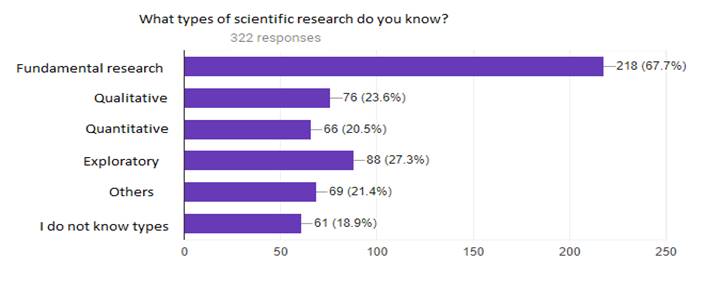
Figure
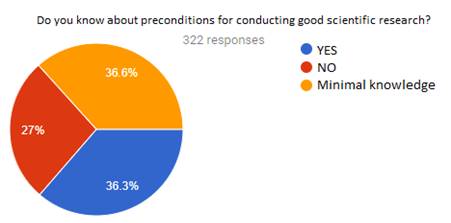
Regarding the issues like the respondents’ knowledge about:
designing a scientific research / the steps of a research;
scientific research tools and methods (questionnaire, focus group, interview, case study, observation, opinion poll, experiment etc);
the methods of data collection or research data analysis.
The research findings show the following- see Figures
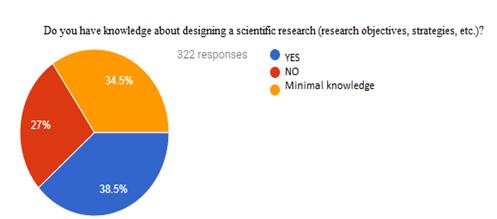
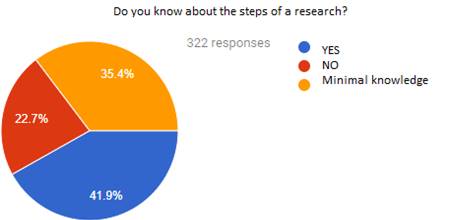
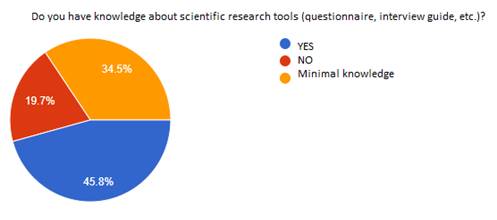
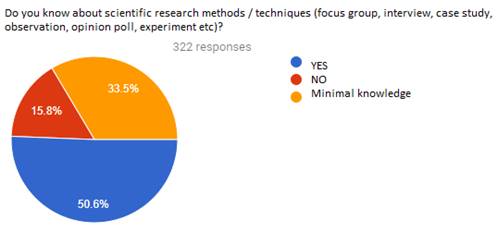
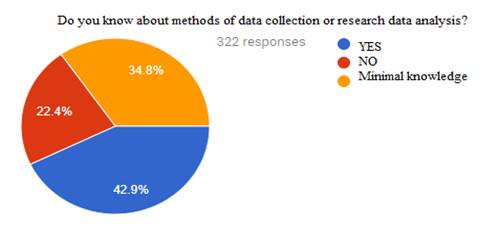
Figures
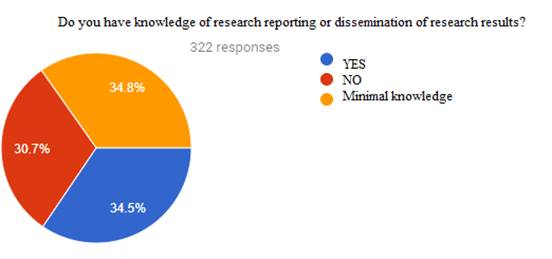
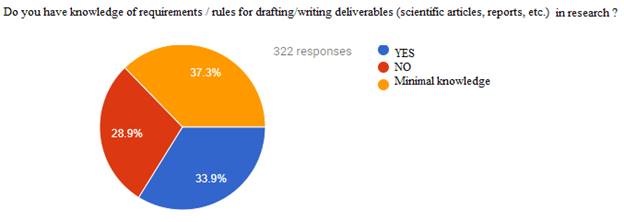
The final questions of the study refer to:
the need for a guide to good practice on how to conduct a scientific research;
the need of training sessions / virtual sessions on topics of interest (including here research in the field of personalizing IT products) in order to increase the level of knowledge (and skills) amongst students in different issues (for example in the field of personalization of IT products) and to grow students' ability in research.
The data analysis reveals the following results – see Figures
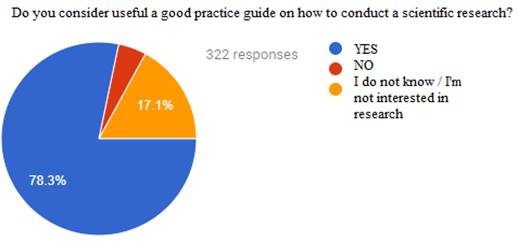
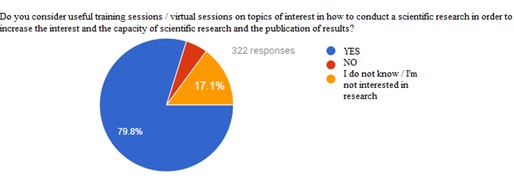
the necessity of research in the field of personalization of IT products - the increasing trend of
having personalized products nowadays is actually a result of many changes in the business environment throughout many year of industrial evolution, hence many suppliers were put in the position to revise their production strategy and their management concepts (Blecker, Friedrich, Kaluza, Abdelkafi, & Kreutler, 2005). Mass customization can be a success under certain circumstance while in a different environment or industry can turn out to be a failure. According to Pine (1993), the homogenous American market led to the extensive development of mass production, also the large consumers’ income was similar among individuals and clients would also express similar needs among themselves. Mass production offers a market with standard quality and accessible prices. The need to have a personalized software should no longer be perceived as a “nice to have” requirement but more as a “must” requirement as the underlay and overlay IT stack is seen as a key strategic component, especially on medium and large companies. Having a personalized software, based on company’s business needs can be a key differentiator in achieving the companies’ strategic objectives and goals on short term but also on medium and long terms.
the need for students in different learning cycles to know and research the IT product
personalization field in order to form abilities, to increase their chances of being employed and to grow the competitiveness of the companies they will work for - with the existing competitive market it’s highly important for students to gain specialized technical skills but also soft skills. This mix of skills is needed for software personalization activities and long term they can serve as means of promotion to management position or professional consultancy.
the need for a guide (for the students’ use) to good practice on personalizing IT products – the
guide should contain aspects like:
definition of personalization of IT products / error in personalization;
principles of personalization / personalization phases.
Some aspects that could be added in the guide are presented below - before starting to personalize any product or service, it’s highly important to identify the correct need for the personalization not just on the short term but also on long term, hence the needs to personalize a software have to be aligned to the strategic vision of the company. When defining the personalization needs of a software, the business owner has to define what are the main expected benefits that will be derived from that particular personalization, also how to quantify and measure the benefits in order to be able to determine at a later stage is the personalization has reached the desired outcome. As the business environment is characterized by dynamism and change has become the only constant, software personalization has to be completed at a fast pace in order to keep up with all the technological innovations. Under these circumstances it’s also very important to decide what project management approach the company takes when engaged in software personalization activities. In order to simplify the decisional process, the business owners would need to focus only on elements that should not change in time. Traditional project management approach implies that all the personalization requirements are delivered even though this would happen in a longer period of time that initial estimated and with higher costs than initial forecasted. The dynamic system development (DSDM) agile method is focused on delivering a minimum viable product (not all requirements) but in a previously set baseline for cost and timelines, also this approach implies a small number of team members to work on the project (8-9 persons) and key aspect to consider is that those team members need to be empowered to take decisions by themselves.

As the customers’ demand on market is to have personalized/unique software having a very short time to market, it would not belong up until complex personalization would be only a click away. This sets the trend to further innovations and process/cost optimization both in technological but also in business segments.
the need for training sessions to increase the level of knowledge (and skills) amongst students in
the field of personalization of IT products and to grow students' ability to personalize IT products - in order to exceed expectations in a challenging and demanding work environment, students need to have a set of skills that are not tied only to the technical background. They need to have a set of professional skills around tools and techniques used project management (at least basic understanding of project management concept, different methodologies used like Agile, Scaled Agile Framework, Scrum, but also the usage of certain tools like Jira).They need to understand and embrace the cultural environment where they work or they are about to work, in software industry majority of the companies are applying Agile approach which by default implies a certain type of mindset (embrace change, autonomy, result focused, collaborative approach). In order to better understand a company and their customer needs it’s very important to understand the industry in which they operate, evolution of the product line and business trends.
Conclusion
In this paper a pilot study has been conducted, having as target group the students and graduates from Romanian technical universities. Also, a case study on the personalization of IT products has been done. The findings and the case study highlighted, among others: what research types and instruments do the respondents know, the need for training sessions to increase students' ability to personalize IT products, the need to develop personalized IT products by students to increase their chances of being employed and to increase the competitiveness of the companies they will work for, the necessity of research in the field of IT products personalization.
As future work we can do a research with a larger target group (1000 persons for example).
References
- Blecker, T, Friedrich, G, Kaluza, B, Abdelkafi, N, & Kreutler, G, (2005). Information and Management Systems for Product Customization, New York, NY: Springer.
- Berman, F. (2018). Building a Research Career, Retrieved from http://math.mit.edu/conferences/wim/conference/career_building.pdfm.
- Centric Software. Configuration vs. Customization: Clarifying the Confusion”, accessed in 2015, Retrieved from https://www.centricsoftware.com/
- DSDM Agile (2016), Retrieved from https://www.agilebusiness.org/.
- Feldman A., Divoll, K., & Rogan‐Klyve, A. (2013). Becoming Researchers: The Participation of Undergraduate and Graduate Students in Scientific Research Groups, Wiley Periodicals, 97, 218–243. https://doi.org/10.1002/sce.21051
- Linn, M. C., Palmer, E., Baranger, A., Gerard, E., & Stonet, E. (2015). Undergraduate research experiences: impacts and opportunities. Science, 347(6222), 1261757–1261757 https://doi.org/10.1126/science.1261757
- Milojević S., (2014). Principles of scientific research team formation and evolution, Proceedings of the National Academy of Sciences of the United States of America, www.pnas.org/lookup/suppl/doi:10.1073/pnas.1309723111/-/DCSupplemental, Retrieved from https://dx.doi.org/10.1073/pnas.1309723111
- Naresh, K. & Birks, D. (2007). Marketing Research. An Applied Approach (3rd European ed.). London, UK: Prentice Hall.
- OECD Glossary of Statistical Terms - Research and development (2001, September 25). Retrieved from https://stats.oecd.org/glossary/detail.asp?ID=2312.
- Pine, B.J. (1993). Mass Customization: The new frontier in business competition, Boston, MA: Harvard Business School Press.
Copyright information

This work is licensed under a Creative Commons Attribution-NonCommercial-NoDerivatives 4.0 International License.
About this article
Publication Date
28 February 2019
Article Doi
eBook ISBN
978-1-80296-055-6
Publisher
Future Academy
Volume
56
Print ISBN (optional)
-
Edition Number
1st Edition
Pages
1-719
Subjects
Pedagogy, education, psychology, linguistics, social sciences
Cite this article as:
Tiganoaia, B., Gavrila, L., Mihai, P., Ionescu, S., & Niculescu, A. (2019). Students Scientific Research Capacity In The Technical Universities From Romania – Case Study On The Personalization Of It Products. In S. Ivanova, & I. Elkina (Eds.), Cognitive - Social, and Behavioural Sciences - icCSBs 2018, vol 56. European Proceedings of Social and Behavioural Sciences (pp. 287-296). Future Academy. https://doi.org/10.15405/epsbs.2019.02.02.32

